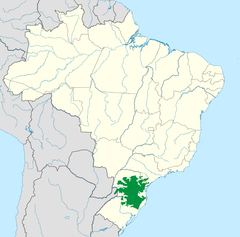Araucaria moist forests
| Araucaria moist forests | |
|---|---|

Araucaria moist forest in Aparados da Serra National Park, Brazil.
|
|

Araucaria moist forests ecoregion as defined by WWF.
|
|
| Ecology | |
| Biome | Atlantic Forest |
| Borders | Alto Paraná Atlantic forests, Cerrado, Pampas and Serra do Mar coastal forests |
| Bird species | 440 |
| Mammal species | 141 |
| Geography | |
| Area | 216,100 km2 (83,400 sq mi) |
| Countries |
|
| States | São Paulo (state), Paraná, Santa Catarina, Rio Grande do Sul and Misiones Province |
| Conservation | |
| Habitat loss | 87.0% |
| Protected | 0.62% |
The Araucaria moist forests are a coniferous forest ecoregion of the Atlantic Forest Biome. The forest ecosystem is located in southern Brazil and northeastern Argentina.
The moist forests cover an area of 216,100 square kilometres (83,400 sq mi), encompassing a region of mountains and plateaus in the Brazilian states of São Paulo, Paraná, Santa Catarina, and Rio Grande do Sul, and extending into Misiones Province of Argentina.
The ecoregion lies above 500 metres (1,600 ft), rising to 1,600 metres (5,200 ft) elevation on the high slopes of the Serra da Mantiqueira.
The ecoregion is bounded by the Paraná-Paraíba interior forests to the north, west, and south, the Cerrado savannas and shrublands to the northeast, The Serra do Mar coastal forests to the east, and the Uruguayan savanna to the southwest.
The Araucaria moist forests have an oceanic temperate climate (Cfb), with frequent frosts during the winter months and considerable snowfalls (generally light) in the highest areas. Annual precipitation is high, ranging from 1,300 to 3,000 millimetres (51 to 118 in), without a dry season.
The ecoregion mostly consists of evergreen subtropical moist forests, with a canopy made up of Ocotea pretiosa and O. catharinense (Lauraceae), Campomanesia xanthocarpa (Myrtaceae), and Parapiptadenia rigida (Leguminosae). Brazilian araucaria (Araucaria angustifolia) forms an emergent layer, growing up to 45 metres (148 ft) in height. The forests are significant from an evolutionary perspective, as a relict of mixed coniferous and broad-leafed forests that were once much more widespread, and are home to many taxa characteristic of the Antarctic flora.
...
Wikipedia
